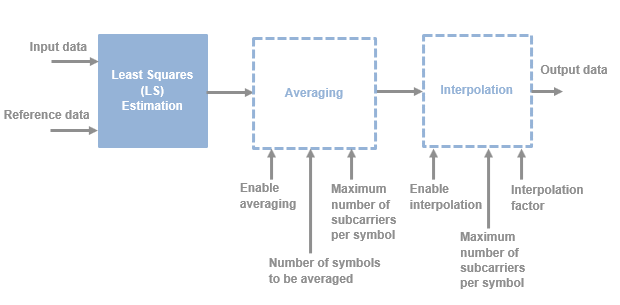OFDM Channel Estimator
Estimate channel using input data and reference subcarriers
Libraries:
Wireless HDL Toolbox /
Modulation
Description
The OFDM Channel Estimator block estimates a channel using input data and reference subcarriers. The block accepts data subcarriers, a valid control port, and refData and refValid reference ports. The block outputs channel estimates and a valid control port. The block allows you to specify the number of subcarriers to estimate for each output symbol.
You can use this block to estimate multipath faded channels on the receiver side in different communications standards, such as long term evolution (LTE) [1] and wireless local area network (WLAN) [4]. To perform proper channel estimation, the refData and refValid ports must be synchronized with the data and valid ports, respectively. For more information about channel estimation and reference data, see Channel Estimation (LTE Toolbox).
This block provides an interface and architecture suitable for HDL code generation and hardware deployment.
Examples
Ports
Input
Output
Parameters
Algorithms
References
[1] 3GPP TS 36.211 version 14.2.0 Release 14. "Physical channels and modulation." LTE - Evolved Universal Terrestrial Radio Access (E-UTRA).
[2] Sesia, Stefania, Issam Toufik, and Matthew Baker, eds. LTE - The UMTS Long Term Evolution: From Theory to Practice. Chichester, UK: John Wiley & Sons, Ltd, 2011. https://doi.org/10.1002/9780470978504.
[3] Dahlman, Erik, Stefan Parkvall, and Johan Sköld. 4G LTE/LTE-Advanced for Mobile Broadband. Second edition. Amsterdam ; New York: Elsevier, 2014.
[4] "Wireless LAN Medium Access Control (MAC) and Physical layer (PHY) Specifications." IEEE Std 802.11 – 2012.
Extended Capabilities
Version History
Introduced in R2020a
See Also
Blocks
Functions
nrChannelEstimate(5G Toolbox) |lteDLChannelEstimate(LTE Toolbox) |wlanLLTFChannelEstimate(WLAN Toolbox)




